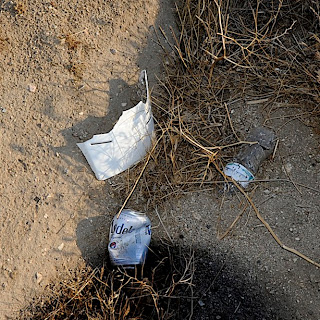Dennis Anderson, Bruce Willis, and the End of the Space Shuttle
Like so many other thousands of people around town on Friday morning, including the SOAR high school students on campus at AVC and most of the other schools around the AV, I went out to see the last circuit of the Space Shuttle Endevour.
My wife had to go to work, so she planned one route, and I another, both of us lingering at home until NASA-on-the-internet told us that the take-off was near.
My wife went to 50th E and L, behind the Skunk Work complex, while I went to the AVC land that some day supposedly will be the Palmdale Campus, where Barrel Springs Road turns into 25th East.
From some high ground, using my oh-so-expensive German birdwatching binoculars, I could see the 747 and shuttle combo take off from Edwards, do their Mojave run, and came back down the center of the Antelope Valley. At point I could have taken a picture of the F-18 chase plane, the shuttle combo, and a hot air balloon all in the same frame --- that is, had I not been a dolt and left my camera at home.
But dolt I was, and so I now rely on the leaky sieve called a memory and the hard copy evidence of the local papers. The Antelope Valley Press was loud and proud, as well it should be. Here is their front page from Saturday.
I love the main headline, and think the invisible subtitle must be "We Built this Spaceship (On Rock and Roll)." The Saturday Los Angeles Times went for a two-fer approach, capturing the combo plane and also the crowd beneath. Give this fellow a Christmas bonus for this shot.
This is an event that has captured our imaginations. My brother in Tucson stepped out from work to photograph the shuttle passing overhead, and my cousin took the day off of work to go to LAX. In my wife's office, everybody came in late so they could see it. Dennis Anderson, in his editorial on Saturday for the AV Press, said several astute things. Besides our being able to say locally "We built that," as it passed overhead, Anderson notes that we "need to remember the massive infusions of national capital in intellect, energy and taxes [ for ] the NASA budget that we all contributed." This event brought out people all over California to witness it, and this was entirely a correct response: as a state, as a nation, this is our spaceship, collectively.
The LA Times probably sensed that, and their interior coverage was so large it wouldn't fit on my $3000 flatbed scanner. Here's a portion of their layout.
Gloomy Gus that I am, as I was watching the shuttle do its victory laps over the Skunk Works and other AV sites, part of me felt as if I were watching the last load of coal be hauled away by the last train from a now-defunct mine.
Will our housing prices ever come back? Will we ever see planes like the B2 or the SR-71 filling up the sky? It seems the end of an era. I am one of those left-right-middle independents who feels that the otherwise liberal NEA (National Endowment of the Arts) should have funded overflights of the Stealth Fighter and the Stealth Bomber, not as examples of military technology, but as art performances in their own right. Say what you want about the evil of warfare (and I would have a LOT to say), in flight, those were some very cool objects.
Of course the shuttle will live on. There's the exhibition itself in Los Angeles, there are the thousands of iPhone pictures taken yesterday along Sierra Highway, and there are the movies. Oh yes, God bless cinema, so that we can still relive biplanes fighting King Kong on the Empire State Building or the shot-full-of-holes B17s of the 1990s remake of Memphis Belle coming back again from their raids on Germany. Even to this day that movie gets my students worrying, "Will they make it?"
So we will have the shuttle in front of us, any time we want to click on the DVD player. According to the LA Times blog site "Movies Now," here are a list of films that use the space shuttle in a small or large way:
1979, James Bond in Moonraker
1986, Space Camp
1998, Bruce Willis and company in Armageddon
2000 (and my favorite), Space Cowboys
2003, The Core
and last, a Bollywood film, 2004, Swades.
In Armageddon, Bruce Willis and Billy Bob Thorton and Ben Afleck and all sorts of oddballs and roughnecks have to save the world from an asteroid. According to IMDb, there is a lot of delicious trivia about this movie. Rockhound's line about sitting on a million pounds of fuel in a rocket built by the lowest bidder is a variation of an actual radio transmission by Mercury astronaut Alan Shepard, just prior to liftoff. In the mission itself, after Rockhound gets space dementia, the shuttle crew wraps him in duct tape, which is (IMDb says), NASA protocol for immobilizing a crazed crew member. Last item --- and in the website, there are many more --- but apparently NASA has shown this film during management training. New managers are given the task of trying to spot as many errors as possible. Supposedly there are more than 168. Well, what can we say? It's a Disney movie, not an actual space launch.
In its fun list, the LA Times blog leaves out the heroic role that a shuttle played in the IMAX movie about the Hubble Space Telescope. And so maybe I am wrong to feel pessimistic. The shuttle on Friday was named after Captain Cook's ship (thank you, Dennis Anderson, for clearing that up for me!), and so that reminds us how universal the urge to explore must truly be.
It may be built in Mojave or even India, but some day the next generation of space shuttle will be in service, and after that, another generation yet.
In the end, here is the view some pilot will have. It may not be in my lifetime, but it is coming.
My wife had to go to work, so she planned one route, and I another, both of us lingering at home until NASA-on-the-internet told us that the take-off was near.
My wife went to 50th E and L, behind the Skunk Work complex, while I went to the AVC land that some day supposedly will be the Palmdale Campus, where Barrel Springs Road turns into 25th East.
From some high ground, using my oh-so-expensive German birdwatching binoculars, I could see the 747 and shuttle combo take off from Edwards, do their Mojave run, and came back down the center of the Antelope Valley. At point I could have taken a picture of the F-18 chase plane, the shuttle combo, and a hot air balloon all in the same frame --- that is, had I not been a dolt and left my camera at home.
But dolt I was, and so I now rely on the leaky sieve called a memory and the hard copy evidence of the local papers. The Antelope Valley Press was loud and proud, as well it should be. Here is their front page from Saturday.
I love the main headline, and think the invisible subtitle must be "We Built this Spaceship (On Rock and Roll)." The Saturday Los Angeles Times went for a two-fer approach, capturing the combo plane and also the crowd beneath. Give this fellow a Christmas bonus for this shot.
This is an event that has captured our imaginations. My brother in Tucson stepped out from work to photograph the shuttle passing overhead, and my cousin took the day off of work to go to LAX. In my wife's office, everybody came in late so they could see it. Dennis Anderson, in his editorial on Saturday for the AV Press, said several astute things. Besides our being able to say locally "We built that," as it passed overhead, Anderson notes that we "need to remember the massive infusions of national capital in intellect, energy and taxes [ for ] the NASA budget that we all contributed." This event brought out people all over California to witness it, and this was entirely a correct response: as a state, as a nation, this is our spaceship, collectively.
The LA Times probably sensed that, and their interior coverage was so large it wouldn't fit on my $3000 flatbed scanner. Here's a portion of their layout.
Gloomy Gus that I am, as I was watching the shuttle do its victory laps over the Skunk Works and other AV sites, part of me felt as if I were watching the last load of coal be hauled away by the last train from a now-defunct mine.
Will our housing prices ever come back? Will we ever see planes like the B2 or the SR-71 filling up the sky? It seems the end of an era. I am one of those left-right-middle independents who feels that the otherwise liberal NEA (National Endowment of the Arts) should have funded overflights of the Stealth Fighter and the Stealth Bomber, not as examples of military technology, but as art performances in their own right. Say what you want about the evil of warfare (and I would have a LOT to say), in flight, those were some very cool objects.
Of course the shuttle will live on. There's the exhibition itself in Los Angeles, there are the thousands of iPhone pictures taken yesterday along Sierra Highway, and there are the movies. Oh yes, God bless cinema, so that we can still relive biplanes fighting King Kong on the Empire State Building or the shot-full-of-holes B17s of the 1990s remake of Memphis Belle coming back again from their raids on Germany. Even to this day that movie gets my students worrying, "Will they make it?"
So we will have the shuttle in front of us, any time we want to click on the DVD player. According to the LA Times blog site "Movies Now," here are a list of films that use the space shuttle in a small or large way:
1979, James Bond in Moonraker
1986, Space Camp
1998, Bruce Willis and company in Armageddon
2000 (and my favorite), Space Cowboys
2003, The Core
and last, a Bollywood film, 2004, Swades.
In Armageddon, Bruce Willis and Billy Bob Thorton and Ben Afleck and all sorts of oddballs and roughnecks have to save the world from an asteroid. According to IMDb, there is a lot of delicious trivia about this movie. Rockhound's line about sitting on a million pounds of fuel in a rocket built by the lowest bidder is a variation of an actual radio transmission by Mercury astronaut Alan Shepard, just prior to liftoff. In the mission itself, after Rockhound gets space dementia, the shuttle crew wraps him in duct tape, which is (IMDb says), NASA protocol for immobilizing a crazed crew member. Last item --- and in the website, there are many more --- but apparently NASA has shown this film during management training. New managers are given the task of trying to spot as many errors as possible. Supposedly there are more than 168. Well, what can we say? It's a Disney movie, not an actual space launch.
In its fun list, the LA Times blog leaves out the heroic role that a shuttle played in the IMAX movie about the Hubble Space Telescope. And so maybe I am wrong to feel pessimistic. The shuttle on Friday was named after Captain Cook's ship (thank you, Dennis Anderson, for clearing that up for me!), and so that reminds us how universal the urge to explore must truly be.
It may be built in Mojave or even India, but some day the next generation of space shuttle will be in service, and after that, another generation yet.
In the end, here is the view some pilot will have. It may not be in my lifetime, but it is coming.






































